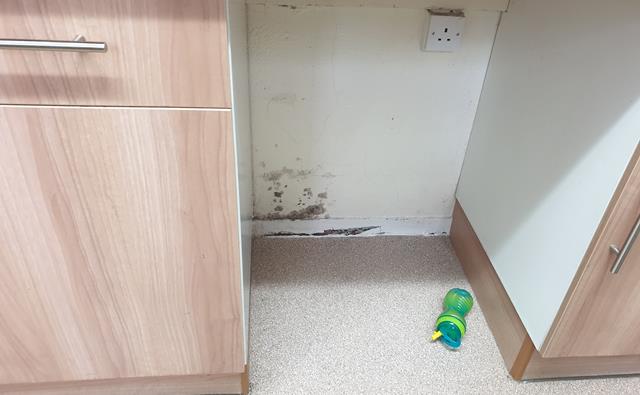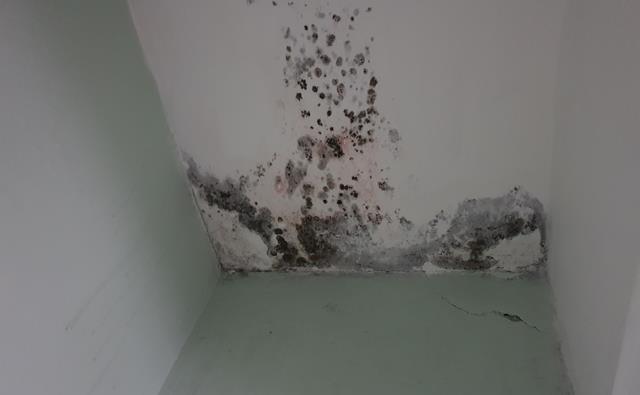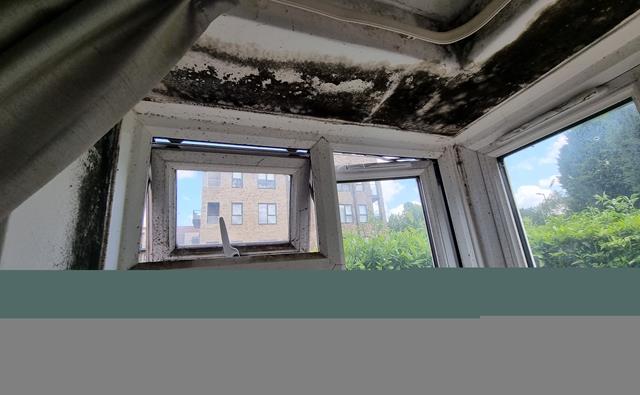If there is damp and mould in your home, we'll work with you to sort it.
Together with Thrive Customer Voice members, we've put together information to help you understand the issue and what to do next. Select from the options below to get started.
What causes damp and mould?
Excess moisture causes mould to grow. Sometimes this can be due to issues such as blocked guttering, damaged window frames, a leaking roof, or wall defects. These are issues we must look into as your landlord.
Another common cause is condensation.
What is condensation?
Water is always in the air but can’t be seen because it’s in vapour form. Condensation happens when warm moist air comes into contact with a cold surface and water droplets form.
You can often see condensation on windows on a cold day or on mirrors after a bath or shower. It isn't always a problem, as long as the surface has time to dry out each day.
Preventing damp and mould
Keeping damp and mould at bay is important for your health and the condition of your home.
If you spot an issue in your home such as a roof leak or issue with your windows, please let us know straight away.
Making sure your home is warm and well ventilated will help prevent condensation and the growth of mould.
Our top tips
-
Reduce the amount of moisture in your home
Moisture in your home is the result of everyday activities. Even just breathing adds moisture.
It’s amazing but true that just one person asleep over one night can add half a pint of water to the air in the room and twice this amount when active during the day.
If you cause less moisture, you will reduce condensation in your home.
Activity Water Moisture A bath or shower 2 pints (1.14 litres) Washing dishes in the sink 2 pints (1.14 litres) Two people at home for 16 hours 3 pints (1.7 litres) Cooking and using a kettle 6 pints (3.4 litres) Drying clothes indoors 9 pints (5.12 litres What can you do?
- Where possible, dry your clothes outside (even on cold days - if the ground looks dry, your clothes will dry too!)
- If drying clothes inside, hang it in the bathroom with the door closed and the window open - and if you have one, turn your extractor fan on.
- If you use a tumble dryer, make sure it is vented to carry moisture outside.
- Cook with the pan lids on. Use the minimum amount of water to cook vegetables and turn down the heat once the water has boiled.
- When filling a bath, run the cold water first, then top up with hot water. This simple rule reduces steam by up to 90% - which prevents condensation.
- Never use bottled gas heaters. They are a safety risk and produce excessive moisture so using them in your home is against your tenancy agreement.
- Never use a gas cooker to heat your kitchen.
- If you use sterilising equipment (for baby bottles and other items) make sure a window is open.
-
Let air into your home
Ventilation (air flow) reduces condensation by removing moist air and replacing it with drier air from outside.
What can you do?
- Reduce overnight condensation by ‘cross-ventilating’. This means opening windows as far as the first notch on the handle, on opposite sides of your home (or upstairs and downstairs). Do this for at least 30 minutes each day to allow dry air through.
- If you have modern windows, lock them in the latch position to allow air through a small gap.
- Place all furniture away from walls, including beds, so air can move freely.
- Leave a gap between the curtains and the wall during the day.
- Open room doors throughout your home.
Remember! If you go out, make sure all the windows are shut and secured.
In the kitchen, bedroom and bathroom:
- Ventilate the kitchen when cooking, washing up or washing clothes by hand. A window slightly open is as good as one that is wide open.
- If you have a cooker extractor hood or extractor fan, turn it on whilst cooking.
- Keep your kitchen and bathroom doors closed to prevent moisture escaping into the rest of your home.
- When you’ve finished in the kitchen or bathroom, open the window for about 20 minutes.
- Leave your bedroom window slightly open at night - unless the window can be easily reached by an intruder.
- If your windows have trickle vents, make sure the vents are open and that they are not blocked up.
-
Heat your home regularly
In all our rented homes, we will make sure you are able to ventilate your property and that you have a heating system which, if properly used, will reduce condensation.
Warm air hangs on to moisture. Cooler air deposits drops of moisture. Think of air like a sponge: the warmer it is, the more moisture is held in it.
If you heat one room to a high level and leave other rooms cold, condensation is likely to be much worse in the unheated rooms. That's why we recommend keeping radiators on low in rooms not in use when you have your heating on.
If you’re struggling to heat you're home due to rising utility costs, see if your entitled to any money support at: thrivehomes.org.uk/money-help
You can also find out more about how to heat your home with as little energy as possible at: thrivehomes.org.uk/heating-guides
-
Clean condensation and mould as soon as it appears
Removing moisture will prevent mould growth.
- Dry your windows and windowsills every morning.
- Wipe dry all surfaces in your kitchen and bathroom that are wet.
Fight mould
Wipe walls and windows or spray them with a fungicidal wash (available at your local supermarket or DIY store). Always read the manufacturer's instructions as some require you to leave the treatment on for a period of time before wiping it off.
What to do if you find damp and mould in your home
Let's help you diagnose the problem
Mould is present if you see ugly small black dots forming that multiply and spread.
It's common to find it in the sealant around your bath, or the seals of a window and this can usually be wiped away using household mould cleaning products.
If the mould is spreading and you aren't able to get rid of it as part of your usual cleaning routine, we need to know about it.
Help us help you - take a look through the examples of mould below to understand the issue before you report it to us.
-
Mild mould
Mould that is in one small section of one room. This could be a corner, around the windows or behind a piece of furniture you have moved.
Let us know about it, and we'll aim to take a look within 28 days.
In the meantime, read our advice on how to treat it and contact us if the issue gets even worse or you are worried about it.

-
Moderate mould
A larger area of mould in one room. This could be a large section of a wall or ceiling.
Let us know about it, and we'll aim to take a look within 10 days.
In the meantime, read our advice on how to treat it and contact us if the issue gets even worse or you are worried about it.

-
Severe mould
Mould that is present across a whole room or in multiple locations across the home. It may be difficult to clean without specialist products or the area is too big to deal with.
If you find this to be case, please call us on 0800 917 6077 straight away.
This amount of mould does not appear overnight and is usually because it hasn't been dealt with early on.
Fortunately, we see very few of these cases because we'll report and fix any issues we find when we pop by for things like regular safety checks and HomePlan visits.
Please let us know about issues as soon as you spot them so we can see to them before they become a bigger problem.

Report damp and mould to us
- Fill in an online form by clicking here
- On the myThrive hub at www.thrivehomes.org.uk/mythrivehub
- Speak to us on live chat at www.thrivehomes.org.uk/talktous
- Email enquiries@thrivehomes.org.uk
If the issue is serious or you are worried about it, please call us on 0800 917 6077.
The more detail you can provide us, the better we can help you.
Please provide us with as much information as possible when reporting an issue. This includes photos of the affected areas and whether you or anyone in your home is vulnerable or has any health issues.
After you've reported damp and mould to us, we will:
- visit you to carry out a full investigation and record our findings (known as a survey report)
- confirm what we found and the next steps in writing or over the phone
- arrange any repairs needed and let you know how long these may take. This may include things like installing new extractor fans, fixing a leak or clearing the guttering
- give you advice about how to prevent damp and mould
- carry out follow up visits to check on the issue.
Keeping you safe in your home
Once we are satisfied the issue has been fixed, we will monitor it for at least three years to make sure it does not become a problem again.
Products we use to treat mould
Below is a list of mould treatment products that we have assessed as safe to use.
All our colleagues have been trained on how to apply these products safely and you can view the manufacturer's safety information and instructions for use in your home by clicking on each product.
These products are available to buy in most supermarkets and DIY stores. Always read the product's instructions as some require you to apply the treatment and leave it on for a period of time before washing it off in order for it to work.
If you are viewing this information offline and need access to the content provided within the web links, please let us know and we'll send you a printed copy.


